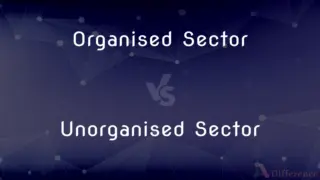Markovnikov Rule vs. Anti Markovnikov Rule — What's the Difference?
Edited by Tayyaba Rehman — By Fiza Rafique — Published on December 18, 2023
Markovnikov Rule predicts the hydrogen will add to the least substituted carbon of an alkene, while Anti Markovnikov Rule predicts the opposite, with hydrogen adding to the more substituted carbon.

Difference Between Markovnikov Rule and Anti Markovnikov Rule
Table of Contents
ADVERTISEMENT
Key Differences
In organic chemistry, the Markovnikov Rule and Anti Markovnikov Rule are guidelines predicting the outcome of addition reactions on alkenes. According to the Markovnikov Rule, when a protic acid like HX is added to an alkene, the hydrogen will bond with the carbon having the most hydrogens. On the other hand, the Anti Markovnikov Rule states the opposite, with hydrogen attaching to the more substituted carbon.
The reasoning behind the Markovnikov Rule is that the addition forms the most stable carbocation possible, typically a tertiary or secondary carbocation. Conversely, the Anti Markovnikov Rule applies mostly when a peroxide or radical initiator is involved, leading to a radical mechanism rather than a carbocation intermediate.
Historically, the Markovnikov Rule was identified by Russian chemist Vladimir Markovnikov in the 19th century. It's widely taught as a general guideline for hydrohalogenation reactions without peroxides. The Anti Markovnikov Rule, acting as its counter, becomes relevant especially in cases where the reaction mechanism is altered, leading to different products.
In practice, knowing both the Markovnikov Rule and Anti Markovnikov Rule allows chemists to predict and control the products of alkene addition reactions. Using the Markovnikov Rule, electrophilic additions typically result in major products that follow this principle. In situations where the Anti Markovnikov Rule applies, free radical mechanisms typically dominate.
Both the Markovnikov Rule and Anti Markovnikov Rule provide a framework for understanding the regioselectivity of alkene addition reactions. By understanding the conditions under which each rule applies, chemists can tailor reactions to yield desired products, emphasizing the importance of both rules in organic synthesis.
ADVERTISEMENT
Comparison Chart
Predicted Addition Site
Hydrogen adds to the least substituted carbon
Hydrogen adds to the more substituted carbon
Reaction Mechanism
Carbocation intermediate
Free radical mechanism
Presence of Peroxides
Generally absent
Typically present
Historical Origin
Predicted by Vladimir Markovnikov in the 19th century
Counter to Markovnikov's prediction
Stability of Resulting Product
Forms the most stable carbocation possible
Does not prioritize carbocation stability
Compare with Definitions
Markovnikov Rule
A guideline emphasizing the formation of the most stable carbocation.
The Markovnikov Rule explains why tertiary carbocations are favored over secondary ones in addition reactions.
Anti Markovnikov Rule
A rule dictating hydrogen's addition to the more substituted carbon of alkenes.
In the presence of peroxides, HBr addition to propene follows the Anti Markovnikov Rule, leading to 1-bromopropane.
Markovnikov Rule
A rule predicting hydrogen's addition to the least substituted carbon in alkenes.
In the addition of HBr to propene, the Markovnikov Rule predicts the major product will be 2-bromopropane.
Anti Markovnikov Rule
A guideline valid for radical mechanisms, often involving peroxides.
The Anti Markovnikov Rule is evident when bromine adds to the terminal carbon in certain hydrobromination reactions.
Markovnikov Rule
An observation for electrophilic addition reactions without peroxides.
Using the Markovnikov Rule, chemists can predict the major product of hydrohalogenation reactions.
Anti Markovnikov Rule
A principle highlighting reactions that don't prioritize carbocation stability.
With peroxide-induced reactions, the Anti Markovnikov Rule predicts the unexpected major product.
Markovnikov Rule
A principle that determines the regioselectivity of alkene addition reactions.
The addition of HCl to 1-butene follows the Markovnikov Rule, yielding 2-chlorobutane.
Anti Markovnikov Rule
A counter rule to Markovnikov's original observation.
The Anti Markovnikov Rule is crucial for understanding product formation when peroxides interfere with typical mechanisms.
Markovnikov Rule
A concept teaching that hydrogen attaches to the carbon with the most hydrogens.
The Markovnikov Rule rationalizes product formation in the hydration of alkenes.
Common Curiosities
Who introduced the Markovnikov Rule?
Russian chemist Vladimir Markovnikov in the 19th century.
What does the Markovnikov Rule predict?
It predicts that hydrogen will add to the least substituted carbon of an alkene.
In which reactions is the Markovnikov Rule commonly applied?
It's often applied in electrophilic addition reactions without peroxides, such as hydrohalogenation.
When is the Anti Markovnikov Rule generally observed?
Mainly in radical mechanisms, often when peroxides are present.
Why is carbocation stability important for the Markovnikov Rule?
The rule is based on the formation of the most stable carbocation possible during the reaction.
Why is the Anti Markovnikov Rule named so?
It acts as a counter to Markovnikov's original prediction.
Does the Anti Markovnikov Rule always require peroxides?
Not always, but peroxides are commonly involved in reactions that follow this rule.
Can reactions ever produce a mix of Markovnikov and Anti Markovnikov products?
Yes, sometimes both products can be formed, but one is usually dominant depending on the conditions.
How does the presence of peroxides influence the product formation?
It often leads to products that follow the Anti Markovnikov Rule due to radical mechanisms.
Which rule is more commonly observed in typical addition reactions?
The Markovnikov Rule is more common unless specific conditions, like the presence of peroxides, dictate otherwise.
Is Markovnikov's rule universally accurate?
No, there are exceptions, especially when other reaction mechanisms or conditions come into play.
How can one differentiate between products of Markovnikov and Anti Markovnikov reactions?
By observing where the hydrogen adds - either to the least substituted (Markovnikov) or more substituted carbon (Anti Markovnikov).
Why is understanding both rules crucial for chemists?
It allows chemists to anticipate and influence the outcome of reactions, guiding the synthesis of desired compounds.
How do the two rules aid in organic synthesis?
They provide chemists guidelines to predict and control the products of alkene addition reactions.
What is the significance of regioselectivity in these rules?
Both rules provide insight into the regioselectivity of addition reactions, predicting where addition will predominantly occur on an alkene.
Share Your Discovery

Previous Comparison
One Way ANOVA vs. Two Way ANOVA
Next Comparison
Organised Sector vs. Unorganised SectorAuthor Spotlight
Written by
Fiza RafiqueFiza Rafique is a skilled content writer at AskDifference.com, where she meticulously refines and enhances written pieces. Drawing from her vast editorial expertise, Fiza ensures clarity, accuracy, and precision in every article. Passionate about language, she continually seeks to elevate the quality of content for readers worldwide.
Edited by
Tayyaba RehmanTayyaba Rehman is a distinguished writer, currently serving as a primary contributor to askdifference.com. As a researcher in semantics and etymology, Tayyaba's passion for the complexity of languages and their distinctions has found a perfect home on the platform. Tayyaba delves into the intricacies of language, distinguishing between commonly confused words and phrases, thereby providing clarity for readers worldwide.














































